Don’t forget to look at the Rusty and Ulla gallery at the end…
This article was written by Chris Hector when Ulla Salzgeber gave the Masterclass at Equitana in Brisbane.
Quite by chance, I ended up watching a demonstration by Pat Parelli on how to teach flying changes. Now Mr Parelli does have a lot of interesting and useful things to say about handling horses on the ground, but it doesn’t do his credibility a lot of good, when he actually sits on a horse. The ‘secret’ had something to do with touching the horse on the rump with a stick – of course most riders know if you breeze a horse through a swinging figure of eight, as Pat was doing, then nine times out of ten it will change, even if it is a little late behind sometimes, as it was in the case here. He may not be such a talented rider, but the man with the mo is very good at finding new words for old truths.
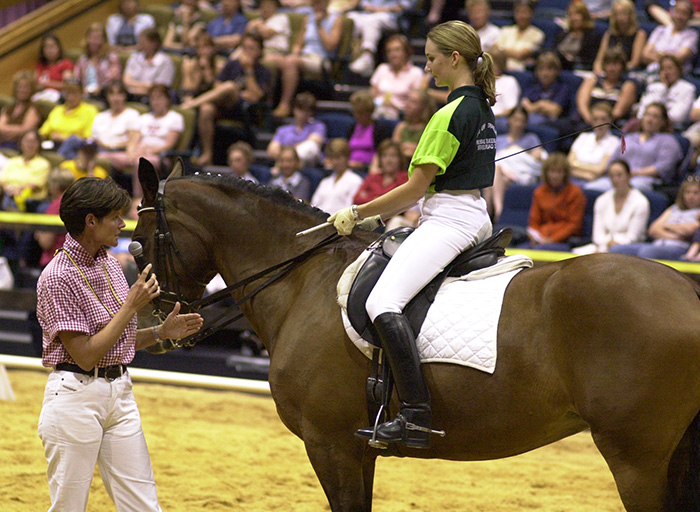
It makes it hard when you go to report on a serious instructor like Ulla Salzgeber, because she doesn’t have any fancy new tricks to show, which is not surprising since her number-one trainer is Ernst Hoyos who spent 29 years in the world’s longest running riding school (the one in Vienna) and her advisor is the octogenarian, General Albert Stecken. All she has is clean, coherent training guidelines for both horse and rider, based on the German Training Scale and her own awesome talent as a rider, and years and years of patiently moulding young riders.
So what are the crucial elements of that German scale? Probably the most important element is the awareness that the rider’s inside rein must allow the horse into contact with the outside rein – which is easy to say, not so easy to do. Look hard at photos of even our top riders and see how often the connection fulfils this requirement. How often is there too much weight on the inside rein, which then restricts the engagement of the horse’s hind leg, and throws the weight of the horse onto the forehand.
Essential then to the freeing of the inside rein, and the nice contact on the outside rein is that the rider be in balance, in the centre of the saddle. Again, this is something that any pony club instructor ‘knows’, but look again, and see how often riders are leaning back, or crooked, or hunched.
I suppose that is what is so frustrating about what Ulla (and Martina, Lisa, Jo, Ernst etc etc etc) have to say. In one sense it is so blindingly simple. On the other hand, it is obviously very difficult to achieve.
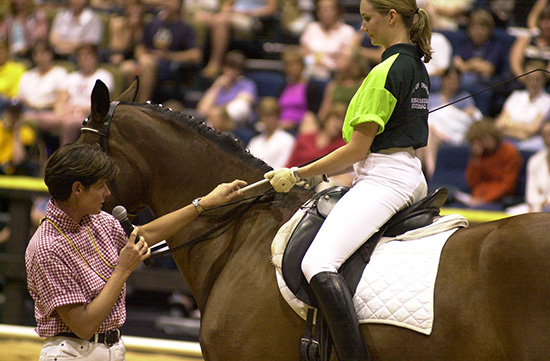
This is where Ulla’s experience as a coach of juniors was so useful. Too often, dressage trainers in this country ignore the rider and concentrate on criticising how the poor horse is going, when in truth he is usually going at least as well as the rider’s poor position and balance allows him. And Ulla had her own ‘magic stick’ and she used it to good effect with all her pupils. Ulla was unhappy with the way her pupils put their hands too far forward, straightening the angle of their elbow. To get them to make the nice straight line from the elbow to the horse’s mouth, Ulla had the rider’s rotate their whip behind them so it pointed backwards and up. With one rider in the clinic before the Equitana, Ulla had her riding with two whips, her stirrups tied to the girth and vowed that if she could think of a way to do it, she would have tied her seat to the saddle at the same time!
Nicole Tough was one who was instructed to keep her whip pointed behind her, with the additional injunction that every time she was tempted to nod her head going ‘yes, yes, yes’ she was to think of shaking it from side to side as if saying ‘no, no, no’.
With the six-year-old Glencoe Manhattan, Nicole was working on collecting the canter and some young horse training pirouettes. The important thing in training the canter is to maintain the quality of the canter – and yes, it is the old collect with the outside rein, keep the activity with the inside leg, and this inside leg became more critical riding the working pirouettes, which started with a circle, with the horse’s inside hindlegs in. “Don’t flex him, just bring his quarters in, keep him on a five metre circle, now into a volte to check that he is on your inside leg. If the horse is not on the inside leg in pirouette you will have trouble getting out of it.”
And that is another secret, when you’ve got it, get out of it! It was a message that Ulla kept stressing over and over, don’t ask for too much, a couple of steps, then get out, relax, refresh, then a couple of steps again…
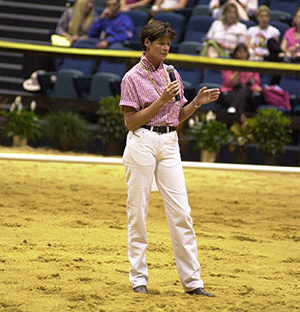
“Try to ride a half pirouette. Ride it big and stay on the outside rein, not too flexed to the inside, and ride out…” Whereupon the rider started pumping with her upper body and again found Ulla a stickler for rider position: “The horse should go more forward, you should not move your body.”
It was the same message for the flying change.
“Now a few flying changes without moving your body. He will do the change from your legs, don’t you move your body.”
And sure enough the changes came up ever so sweetly (I guess she never considered sending Nicole off at three quarter pace on the buckle for a series of figure eights!)
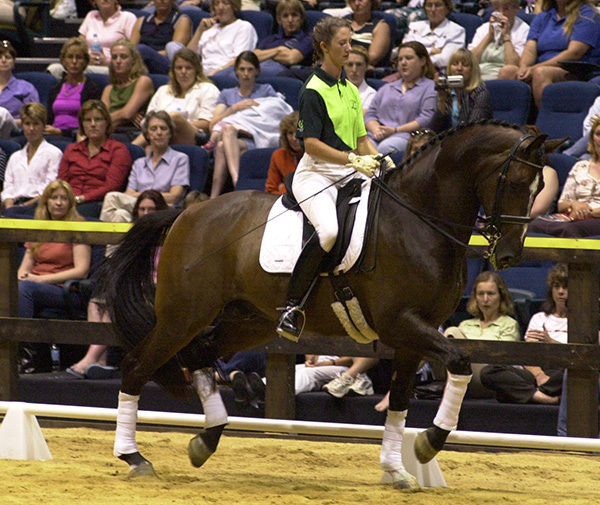
Kelly Layne and a nine-year-old Amoucher
The next in for the clinic was Kelly Layne and the nine-year-old imported Hanoverian gelding, Amoucher. Kelly said she was hoping to demonstrate some Grand Prix movements, whereupon ‘Smooch’ tried to wipe out the visitor: “Is this part of the exercise of Grand Prix in Australia? Kill the teacher!”
Kelly’s Amoucher is a spectacular mover, but he is also fairly hot and spooky, and time for another invaluable tip from Ulla:
“Never try to ride your horse to something he finds scary with your outside rein. Flex the horse with the inside leg, and think of shoulder in as you go to whatever he finds scary, push there with your inside leg instead of trying to pull him there with the rein.”
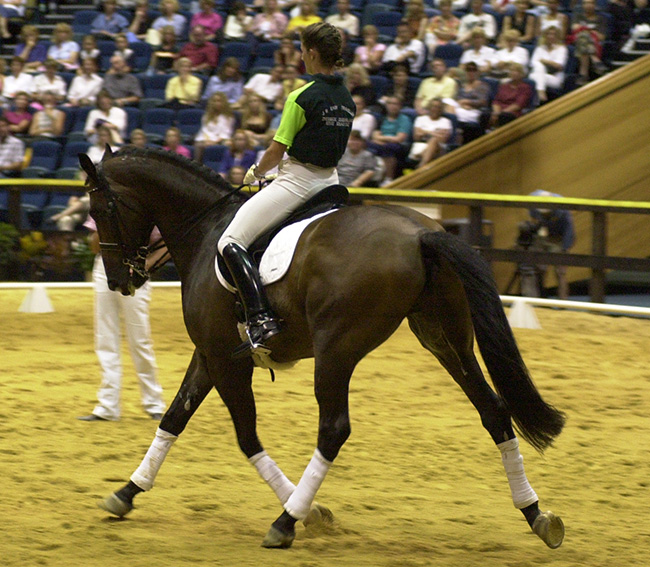
Horse under control it was time to work on some half passes, and here, according to Ulla, the most important thing is ‘to keep his bum under control. Think more shoulder in, even get him a little deep – later you can bring his neck up, in the meantime, it is better to have him flexed.”
Flexing the horse was a crucial element of control at many points in Ulla’s working session. Even when asking for a few steps of piaffe, Kelly was asked to flex Amoucher to the inside to make him concentrate a little more. Flex him again, he is looking to the door…”
Not that Ulla minded that the horse was a bit hot: “Good horses have to be a little like him. If they are dead they never have the power they need.”
And even a rider as elegantly correct as Kelly came in for the position critique: “See she is falling a little to the front when she goes to medium trot, and that is why the horse goes to canter. She did it again, exactly the same mistake, and the horse cantered again – it is a well-educated horse! You must not get out of the saddle and then back into the saddle, it interrupts the movement. Kelly stay sitting, the horse should be more hill up.”
‘Hill Up’ was a wonderful Ulla-ism, along with ‘crinkled’ which is so much more expressive than the more customary, ‘crooked’.
“When he twists his neck in the half pass, it shows that he is not truly on the outside rein. Flex him to the outside to make sure he takes the outside rein.
more rider position next
Dancier, top producing stallion from the famous D line, you can breed to him,
find out how: www.ihb.com.au
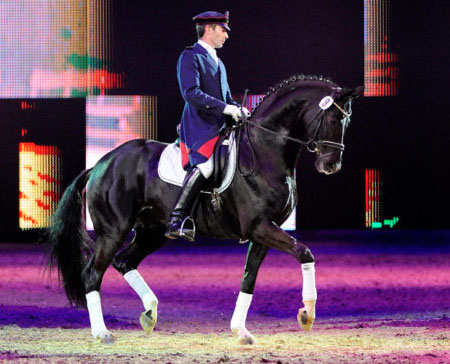
or what about the exciting Fürstenlook?
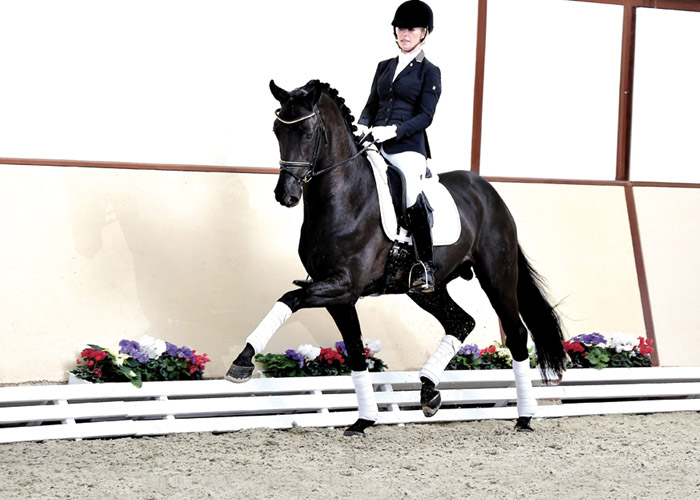
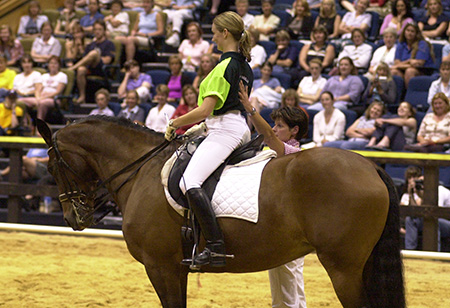
Sara McDonald was another who had been given the ‘rider position treatment’ big time, but the effect was just startling. I’d seen Adloo Georgia only a few weeks earlier at the Australian Dressage Championships, and now she was so much more engaged and forward after the time in the Ulla Clinic. Improve the rider – improve the horse…
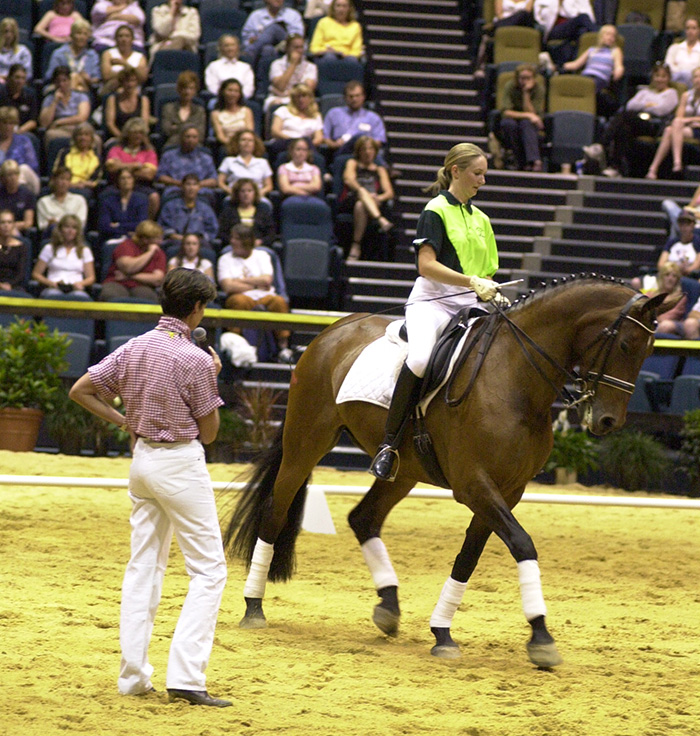
“The position of the rider is the most important thing. Without the right position, you will never ride the horse in the correct way. Down your heels, they should be the deepest part of the rider’s body. Down, down, down, open your muscles, don’t press your knee on the saddle. Turn your feet in a little more, but you should turn your toes by starting at the hip – if you just try to turn your feet it will hurt. We don’t want the rider’s knee so open that you could shoot a ball through the space, but we don’t want it too tight either. If the knee is too tight you can’t turn your foot. Shorten the inside rein for the shoulder in because your hands should always remain in the same position. Right hand on the right hand side of the horse, left hand on the left side. Flex the horse a little more at home because at a competition, you will always lose some of it. It is easier to train with more than less. Play with her mouth, it is something living, something very soft.”
In the canter half pass, the rider had to give the aids for a canter strike off every stride of the half pass. “Every stride, give the aids as if you are going into canter, and if you have to take the inside rein a little, remember you have to use the inside leg more to keep the inside hind leg active.”
And this was another rider who had to stay quieter in the flying change: “The change was good but you have to stay sitting on your bum – no air between the saddle and the bum.”
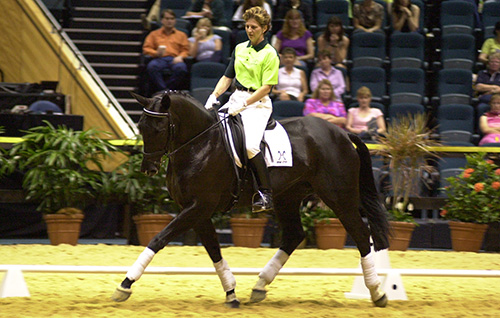
I have a feeling that perhaps Liz Owens and her six year old mare, Class Action would have preferred to be at Pat’s Flying Change clinic, it certainly would have been much easier to just breeze through the changes with a big change of direction – it was the change of direction that Ulla had nominated as a problem…
“In the flying change the horse always comes a bit against Liz and when she makes the change she is really flying, two metres in the new direction. We are trying to make the change and keep the horse straight. So we make her a little more round so it is easier to keep her under control. Now try the change, a fluid, collected canter, never bring her back before the flying change because you want a big expressive change, and try not to pull her head in the new direction…”
And the handsome black mare stayed absolutely straight as she tossed off a big expressive, brilliant flying change! Or she would have if there were simple magic solutions to every problem. The truth is she got hot and bothered, then more hot and bothered, and that perfect change is looking further and further away. At this point, Ulla confronts the options: “We have two choices. We could keep working for two or three hours and get it, or put her away and come back and try again in a couple of hours. But first we will make a little leg yield as we shouldn’t finish on the bad note.”
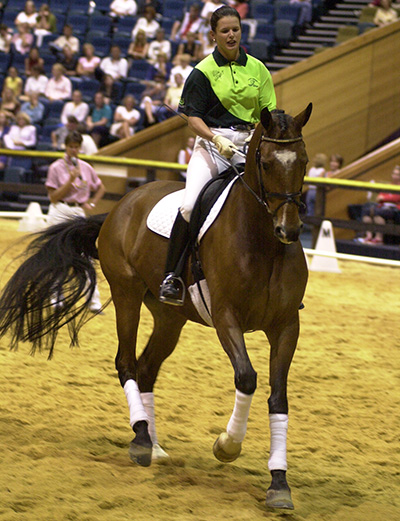
And we finished on a nice note too, with a very pleasant session with Kate Overton and her eight-year-old La Viva. They too worked on the canter pirouette.
“Think of a very little circle, forget the word ‘pirouette’. Riders hear the word pirouette and get fear. If they just think a little circle, get the flexion, get the turn, give the aid for canter every stride. Make him faster behind, no more speed, just faster behind.”
There are even some nice four tempi changes even if they could have been a little more ‘hill up’.
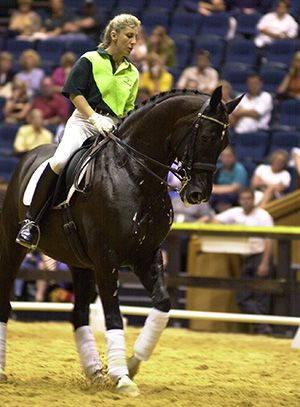
Then it was time for Ann Serrao to get her reward. She had lent both her horses, Wisdom and Centaur to Ulla for the Mane Event, and now she had Ulla’s undivided attention as she rode the eight year old Wisdom, trying for the one times changes. “Start left / right, then left / right / left, left / right / left / right, adding one each day.”
More pirouettes: “Normally you go into pirouette and the outside rein is gone. I say ‘keep him straighter’ and it helps the rider keep the outside rein.”
And even after what had been a long, long clinic, Ulla is a stickler for detail, even as the horse is warming down it must be done correctly:
“Even when you give the rein, he is not allowed to run away. Keep the rhythm.”
Rusty and Ulla Gallery of Pix
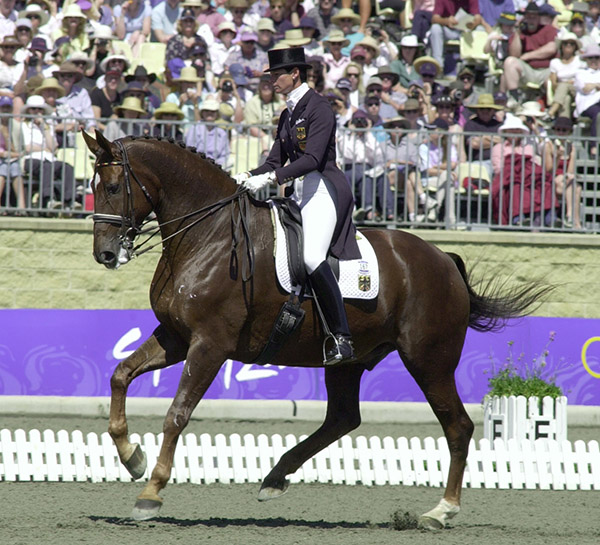
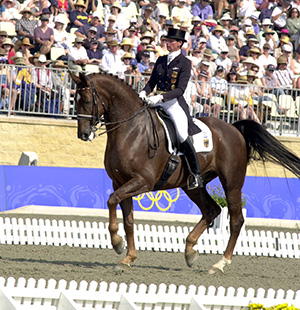
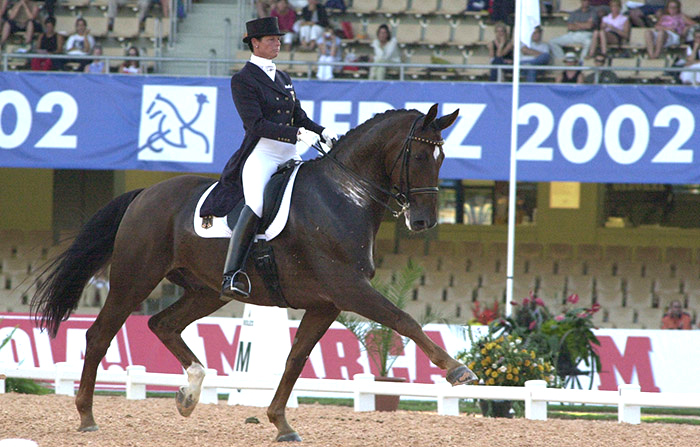
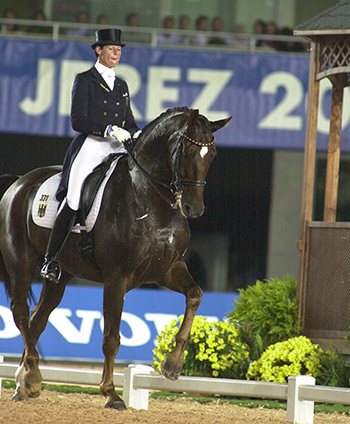
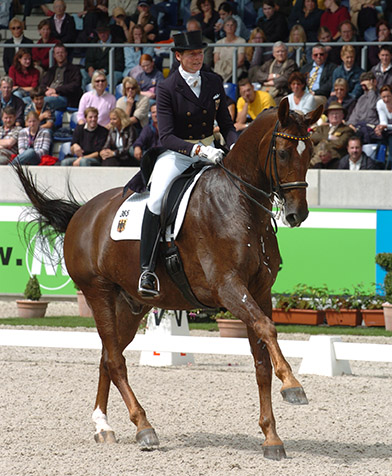
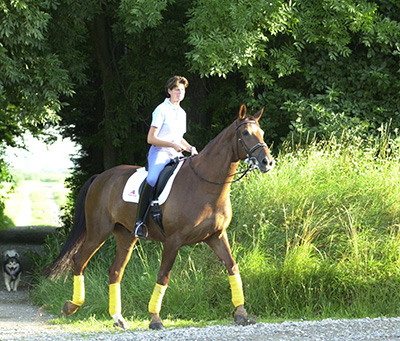


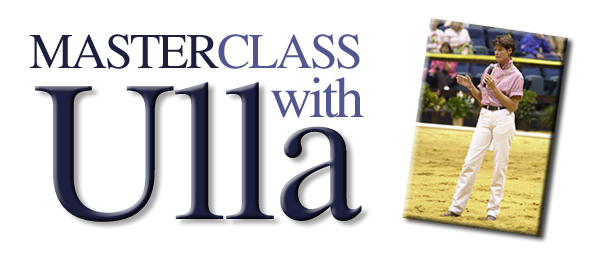
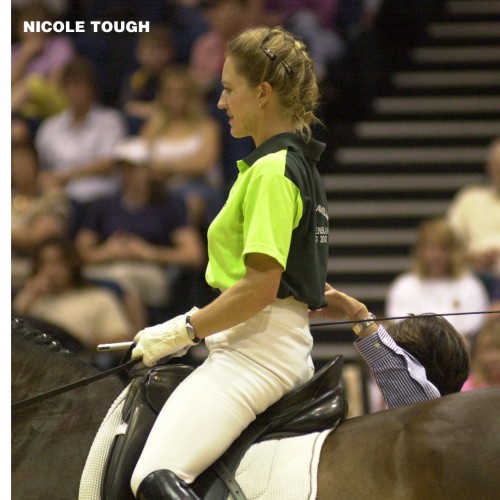
Brilliant!!! Succinct. I saw Ulla and Rusty at Sydney. Just a beautiful picture. Thank you for this Chris.
Megan Joerg.
She is a legend and I just love her. I saw her clinic once in the middle of nowhere Ohio, probably 2003 or so. She was so excited for each horse and rider and was talking about the benefits of training the rider in a Portuguese saddle. Truly a delight who brought classical thinking and European mystique to the dreary state of Ohio. I still think back to that clinic occasionally.